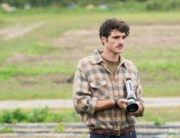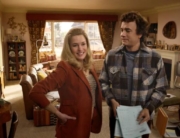
Since it was first published in 1911, Frances Hodgson Burnett’s classic novel The Secret Garden has been adapted into a Broadway musical and several films, including MGM’s 1949 version with Margaret O’Brien as Mary Lennox and Dean Stockwell as Colin Craven, as well as Agnieszka Holland’s acclaimed 1993 adaptation. Now 27 years later, this timeless tale of childhood lost and redeemed through the healing powers of nature and friendship returns to the screen.
Adapted by Jack Thorne (Radioactive) and directed by British television director Marc Munden (National Treasure), the story line has been updated from its Edwardian roots to open in 1947 on the eve of the Partition between India and Pakistan. Against the sounds of violent chaos outside, a frightened 10-year-old Mary (Summerland’s Dixie Egerickx) comforts herself by telling a story to her doll with shadow puppets. In the morning, she discovers that she is alone in a wrecked house, with no sign of her parents or the household servants. Eventually she is rescued by British soldiers and learns her parents died in a cholera epidemic.
The orphan, haughty and angry, is shipped back to England to live with her dour uncle Archibald Craven (Colin Firth) at his remote Yorkshire estate, Misselthwaite Manor, under the stern eye of housekeeper Mrs. Medlock (Julie Walters), who warns Mary not to stare at Archibald’s hunched back. The grand house is a gloomy, spooky wreck, and as Mary wanders its dark, dilapidated halls, she hears a strange ghostly sobbing that eventually leads her to the bedroom of her bedridden cousin Colin (Edan Hayhurst), an invalid who is as disagreeable as Mary. “You are very thin,” he tells her. “And you are very white,” she replies tartly. A prickly friendship develops as Mary introduces Colin to Dickon (Amir Wilson), the animal-loving younger brother of a housemaid, and the mysterious secret garden she has discovered.
And what a CGI-enhanced garden it is, blooming and withering with the children’s moods. The movie was shot by cinematographer Lol Crawley in some of Britain’s most stunning gardens, including Wales’s Laburnum Arch and Cornwall’s subtropical Trebnah Gardens, but the result is a botanical hodgepodge that would give horticulturalists pause. Lush tree ferns and towering gunnera in stark Yorkshire? How did such an enormous garden, really more of an expansive park, remain secret?
In the novel, Mary asks Archibald for a “bit of earth,” and she sets out to restore the secret garden to life. In the process of learning how to garden, the spoiled little girl who had once refused to dress herself begins to blossom. But by making the garden literally a magical place, whose pond waters miraculously heal Colin, the filmmakers undermine the book’s theme of personal redemption and strip the story of its inherent magic and charm.
The film is further undermined by a script that focuses on the psychodrama between the grieving Archibald and Colin, the son he has forced to live the life of an invalid out of misplaced overprotectiveness. As Mary and Colin uncover the roots of Archibald’s obsessive grief and her mother’s aloofness (not addressed in the novel), the pair begin to sound like mini psychotherapists. (Colin: “Maybe we knew neither of our parents.”) Adults and children may grow bored.
The grown-up characters don’t fare much better. Walters has nothing much to do as Mrs. Medlock except to look stern, and a haggard and glum Firth weeps, glowers, and mumbles, a far cry from his dashing Mr. Darcy days. In an interesting connection, Firth played the adult Colin Craven in a 1987 Hallmark television adaptation.
The film is a clunky mix of magical realism (the wallpaper springs to life as Mary is transported to her Indian home in her dream) and gothic romance (the ghosts of two dead mothers drift through the manor’s halls). Additionally, the fiery climax is straight out of Jane Eyre, and unnecessary. The saving grace, Oscar winner Dario Marianelli’s (Atonement) evocative and haunting score, captures the magic the film lacks.
















Leave A Comment